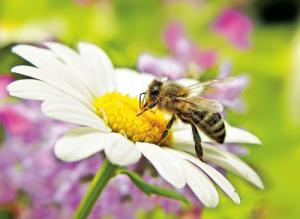 The real food movement isn’t going anywhere as 57 percent of people have reported searching for foods made with simple, real ingredients. Honey—a natural sweetener often used for tea, baking and on toast—is pure and simply harvested from honeycombs with no added ingredients or preservatives. With more than 300 varietals of honey in the United States and a multitude of culinary uses, honey is becoming an even more popular ingredient for those seeking a more natural approach to their foods.
The real food movement isn’t going anywhere as 57 percent of people have reported searching for foods made with simple, real ingredients. Honey—a natural sweetener often used for tea, baking and on toast—is pure and simply harvested from honeycombs with no added ingredients or preservatives. With more than 300 varietals of honey in the United States and a multitude of culinary uses, honey is becoming an even more popular ingredient for those seeking a more natural approach to their foods.
However, the story from honey bee to table is sometimes misunderstood so misperceptions on authenticity, sourcing and bottling exist. The National Honey Board (NHB), a federal research and promotion board with the United States Department of Agriculture (USDA) oversight, has compiled The Sweet Truth Behind Honey educational platform to provide reliable resources and sustain consumer confidence in this versatile everyday pantry staple.
The NHB conducted an Attitude and Usage (A&U) study and learned first-hand that a majority of current users, past purchasers and non-purchasers report it is important for honey to be pure. Honey is just that, made by honey bees from the nectar of flowers and plants, not from pollen. This is just one of several myths that need clarification, according to the NHB.
“Honey is produced by honey bees from the nectar in flowers. Some plants have flowers with nectar, some that just have pollen, and some have both,” says 40-year veteran beekeeper Gene Brandi. “Nectar is a sugar-water solution that is found at the base of nectar-producing flowers. The bees collect the nectar and bring it back to the colony, store it and dehydrate it, and eventually turn it into honey.”
Consumer confusion doesn’t stop once honey reaches the honeycomb. The bright color of typical honey in the supermarket is a result of filtering, which improves clarity. Research supports that filtering honey doesn’t impact the nutrient content or antioxidant activity. Honey is made by honey bees from nectar of flowers and plants, not pollen. Pollen grains are seen as an accidental guest in honey, brought back as a food source for the baby bees. While filtering honey, the air bubbles, fine particles, other material in suspension and pollen grains are removed. Honey without pollen is still honey, nutritionally and in flavor.
“U.S. honey packers are filtering out the impurities and the particles because that is what causes honey to crystallize. One of the things that we’re doing through the filtering step is extending the shelf life of honey, which is also a quality of honey that is important to consumers,” cites beekeeper and honey packer Brent Barkman, Chairman of the NHB. “From research we know that consumers like a clear, golden product that’s also free of particles and won’t crystallize in the pantry. We’re always looking for the highest quality product that we can provide to the consumer.”
While more than 83 percent of consumers are aware of the wide range of more than 300 honey varietals in the United States, most respondents actually buy honey for use in baking, tea or on toast. “In terms of functionality and how to use honey in recipes the list is very long,” notes Marie Simmons, award-winning cookbook author and spokesperson for the NHB. “Honey is a natural flavor booster that works well in both sweet and savory dishes. It adds distinctive flavor notes, rich golden colors, balances the taste and holds and attracts moisture, especially important in baked goods. Additionally, honey is naturally antimicrobial, and therefore helps to prevent foods from spoiling.”
Honey is a natural product that contains just one ingredient: honey. The versatility of honey makes it easily accessible for consumers to use in their daily routines. Honey is a whole food, and as a carbohydrate, is considered a natural energy booster. Honey also has other uses outside of the culinary realm. With humectant properties, honey draws and retains moisture to help hydrate the skin. It is also recommended by the American Academy of Pediatrics and the World Health Organization as a natural cough suppressant in children after the age of one.

You must be logged in to post a comment Login